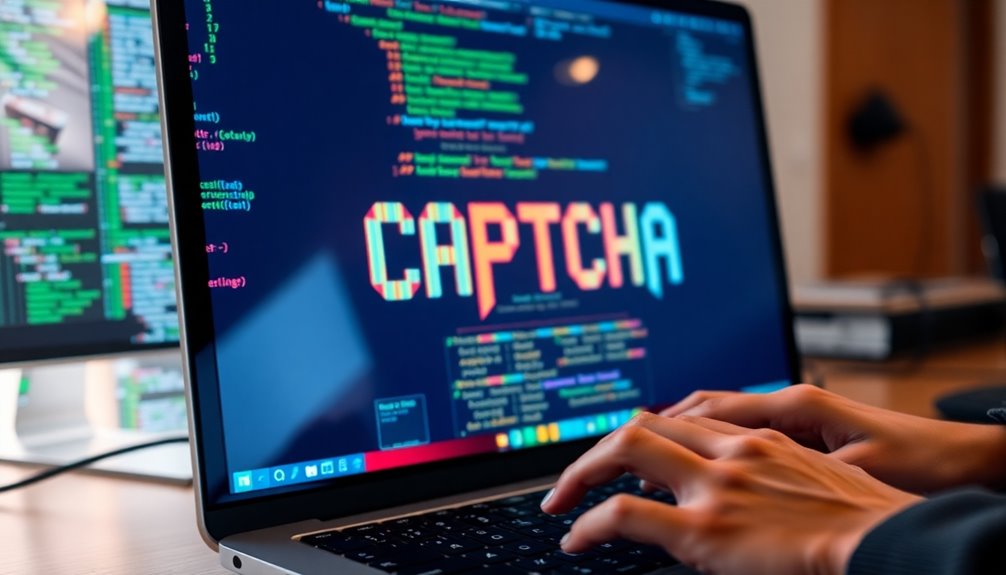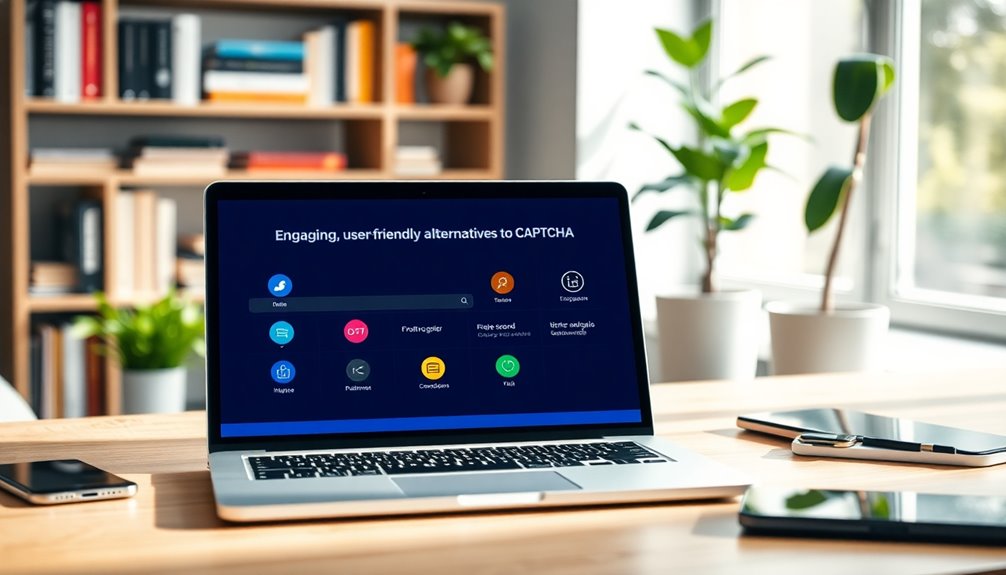CAPTCHA stands for Completely Automated Public Turing test to tell Computers and Humans Apart, designed to protect websites from spam and automated bots. You've likely encountered it while identifying distorted characters or selecting images. It works by asking you to complete tasks that are simple for humans but tricky for computers. Over the years, CAPTCHA has evolved from text-based challenges to more engaging formats like image recognition. While it enhances online security and reduces spam, it also faces challenges, particularly for users with disabilities. If you're curious about its types and future developments, there's more to explore.
What Is CAPTCHA?
When you encounter a CAPTCHA, you're engaging with a tool designed to distinguish between human users and automated bots. CAPTCHA stands for Completely Automated Public Turing test to tell Computers and Humans Apart. Developed in the 1990s, this technology combats spam and enhances security across websites.
As a usuario, you often face challenges that are simple for you but tricky for bots, like identifying distorted characters or selecting specific images. CAPTCHA serves as a prueba de Turing, testing your ability to complete tasks that require human-like perception.
Common applications include online forms, account registrations, and securing sensitive information retrieval. This helps prevent automated attacks that could compromise your data. Implementing techniques such as limiting login attempts can further reduce the risk of these attacks.
The effectiveness of CAPTCHA hinges on its ability to evolve alongside advancements in machine learning and automation. This means developers regularly update CAPTCHA technology to stay ahead of increasingly sophisticated bots.
Various types exist, including text-based, visual, and logical question formats, all aimed at enhancing user verification while minimizing spam and malicious activity.
Purpose of CAPTCHA
CAPTCHA plays an essential role in online security by effectively distinguishing human users from automated bots. This differentiation is important to maintaining the integrity of your online interactions.
Here are three key purposes of CAPTCHA:
- Preventing Spam: CAPTCHA helps block automated bots from flooding your web applications with spam, ensuring that only genuine usuarios can submit forms or comments.
- Protecting Accounts: It acts as a security filter during sensitive actions like account registrations and logins, preventing malicious bots from creating fake accounts or executing brute force attacks. Additionally, implementing multi-factor authentication alongside CAPTCHA further enhances the security of user accounts.
- Enhancing Security: By requiring users to complete tasks that are simple for humanos but challenging for bots, CAPTCHA safeguards your information and enhances overall web seguridad.
In an age where automation technology is advancing rapidly, CAPTCHA continues to evolve. It adapts to new threats, ensuring that your online experiences remain secure. Implementing additional measures such as two-factor authentication can further protect your accounts from unauthorized access.
Next time you encounter a CAPTCHA on a website, remember that it's not just a test; it's an essential measure to protect you and other users from potential harm.
History of CAPTCHA

You might find it interesting that CAPTCHA was first created in the late 1990s by Luis von Ahn and his team to combat spam and automated online abuse.
By 2000, the term "CAPTCHA" was coined, highlighting its role as a test to separate humans from bots. Since then, CAPTCHA technology has evolved considerably, incorporating more complex methods like image recognition and behavior analysis. Additionally, implementing security plugins can enhance website protection against automated attacks, reinforcing the importance of robust security measures. This is especially crucial given that weak passwords are a common entry point for hackers, emphasizing the need for comprehensive security strategies. In fact, using tools like MalCare Security Plugin can provide automatic daily scans to ensure your website remains secure.
Origins of CAPTCHA Development
As the internet began to flourish in the late 1990s, researchers at Carnegie Mellon University recognized the need for a solution to combat spam and automated abuses in web applications. This led to the development of CAPTCHA, or "Completely Automated Public Turing test to tell Computers and Humans Apart," which was coined in 2000 by these innovative investigadores de la Universidad, including Luis von Ahn.
The early implementations of CAPTCHA primarily used distorted text images, designed to serve as la prueba that only human users could interpret.
Here are three key elements that shaped its origins:
- Distorted Text: The original CAPTCHAs relied on challenging text images, assuming that bots would struggle to read them.
- Human Verification: The goal was to guarantee that actions on websites were performed by humans, not robots.
- Evolution with AI: As la inteligencia artificial advanced, the need arose for CAPTCHAs to evolve beyond los CAPTCHA tradicionales.
This continuous adaptation was essential to counteract sophisticated bots that increasingly recognized and bypassed these early formats.
The journey of CAPTCHA technology began as a response to a growing threat in the digital world.
Evolution of CAPTCHA Technology
With the rapid advancement of technology and the rise of increasingly sophisticated bots, the landscape of CAPTCHA has undergone significant transformation since its inception. Originally developed in the late 1990s by Luis von Ahn and his team, early CAPTCHAs relied on distorted text images that humans could decipher but computers struggled with.
However, as automation and machine learning progressed, these traditional text-based CAPTCHAs became less effective. This evolution de CAPTCHA led to the creation of more advanced solutions like image-based and behavioral CAPTCHAs, which are designed to outsmart bots more effectively.
In 2009, Google acquired reCAPTCHA, enhancing its capabilities by using human interactions to improve inteligencia artificial systems. This development not only bolstered security but also contributed to ongoing efforts in combating automated attacks.
Today, the continuous adaptation and evolución de CAPTCHA technology are essential to maintaining online seguridad. As bots grow more sophisticated, CAPTCHA must evolve to guarantee that you, as a user, can safely navigate the web without interruptions.
Embracing these advancements helps protect both you and the digital landscape from potential threats.
Types of CAPTCHA
Various types of CAPTCHA are commonly used to distinguish humans from bots during online interactions. These methods guarantee that only real users can access certain features or content.
Here are some popular tipos de CAPTCHA:
- Reconocimiento de imágenes: You might be asked to select images that meet a specific criterion, like identifying all traffic lights in a grid. This method tests your visual recognition skills, similar to how automated backup solutions utilize encrypted backups to protect sensitive data.
- Preguntas lógicas: Simple, common knowledge questions are posed to you. These questions typically require human reasoning to answer correctly, making it difficult for bots to succeed.
- Problemas matemáticos: You often encounter basic arithmetic problems or simple sequences that you need to solve. This straightforward approach verifies your humanity through your ability to perform mathematical tasks.
Additionally, ludic CAPTCHAs add an entertaining twist by engaging you in dynamic tasks that are both fun and a means of identity verification. Implementing effective CAPTCHAs is crucial to safeguarding websites against automated threats and ensuring a secure user experience.
Each type of CAPTCHA plays an important role in making sure that online environments remain secure and user-friendly, effectively separating humanos de los bots.
Text-based CAPTCHAs

Text-based CAPTCHAs are designed to challenge your ability to interpret distorted alphanumeric characters displayed in an image. These CAPTCHAs require you to enter the characters you see, relying on your human ability to decipher various fonts and styles. They were among the first types of CAPTCHA developed, based on the premise that automated sistemas would struggle to decode the visual distorsiones effectively.
The complexity of these text-based challenges can vary considerably. Some CAPTCHAs incorporate background noise or overlapping characters, making it even more difficult for automated recognition tools to succeed. Regular updates to CAPTCHA technology are essential to counteract advancements in AI.
However, as technology evolves, these CAPTCHAs are increasingly vulnerable to sophisticated AI and machine learning algorithms that can learn to bypass them.
While text-based CAPTCHAs were once a reliable security measure, concerns about user experience and accesibilidad have led to a decline in their use. Many users find them frustrating, especially those with visual impairments.
As a result, developers are moving towards more advanced CAPTCHA types that improve accessibility and enhance security, leaving traditional text-based CAPTCHAs behind. Additionally, the increasing reliance on secure coding practices highlights the need for better security measures against automated threats.
Visual CAPTCHAs
Visual CAPTCHAs challenge you to select images that meet specific criteria, like picking out all the pictures with traffic lights. This not only tests your recognition skills but also keeps you engaged in the verification process. Unlike text-based CAPTCHAs, these image selection tasks can vary in difficulty, adding an extra layer of challenge that automated bots often struggle to overcome. Additionally, implementing a lightweight design for websites can enhance user experience, making it easier for users to interact with CAPTCHAs effectively. To further improve user engagement, consider incorporating Call to Action widgets that encourage interaction with the CAPTCHA process. Regular evaluations to identify unused plugins can also help streamline the CAPTCHA experience and improve overall site performance.
Image Selection Challenges
Image selection challenges, commonly known as visual CAPTCHAs, require you to pick specific images from a grid based on given criteria. For instance, you might need to find all the pictures containing traffic lights or bicycles. These CAPTCHAs leverage your human visual recognition abilities, making them easy for you while challenging for bots.
Here are three key features of image selection challenges:
- Grid Format: Usually, you'll see 9 to 16 images to choose from, making it visually engaging.
- Majority Response Validation: Your selections are compared to previous users' responses, enhancing the accuracy of the captcha.
- Accessibility Options: For usuarios con discapacidad visual, audio alternatives allow you to complete the challenge through distorted sounds or spoken instructions.
As automated bots advance, visual CAPTCHAs evolve too. They now analyze your comportamiento del usuario, like mouse movements, to distinguish human interactions from automated responses.
This guarantees that the captcha remains a reliable test while improving the experiencia del usuario. So, next time you face an image selection challenge, remember its role in keeping online spaces secure!
User Engagement Benefits
Many users appreciate the interactive nature of CAPTCHAs that require selecting images to meet specific criteria. This visual approach not only enhances the experiencia del usuario but also provides a more engaging interaction compared to traditional text-based CAPTCHAs.
By using familiar objects, you'll find that these CAPTCHAs are easier to understand and solve, which boosts your satisfacción. Studies show that users typically find visual CAPTCHAs less frustrating, as they eliminate the challenges posed by distorted text.
With higher completion rates for online forms, you're less likely to abandon a process when faced with a visual CAPTCHA. This means you get a smoother experience, encouraging you to continue using the website.
Moreover, these CAPTCHAs improve seguridad by effectively verifying human identity while fostering a positive relationship between you and the site. By creating an engaging environment, visual CAPTCHAs help build trust and retention among usuarios.
Logical and Math CAPTCHAs

Logical and Math CAPTCHAs offer users a straightforward way to verify their identity while ensuring that automated bots can't easily bypass these challenges.
These types of CAPTCHAs require you to use your knowledge of lógica and matemáticas to solve simple problems, making it easy for humanos like you to prove you're not a robot. Additionally, implementing security plugins can further safeguard your website against malicious attacks.
Here are three common types of Logical and Math CAPTCHAs you might encounter:
- Logical Questions: Answer questions based on common knowledge, such as "What color is the sky on a clear day?"
- Basic Arithmetic: Solve simple math problems like "What is 5 + 3?" or "Subtract 2 from 10."
- Pattern Recognition: Identify the next number in a sequence, such as "2, 4, 6, ?"
These CAPTCHAs are designed to be easily solvable by you, enhancing your user experience.
They reduce the frustration often tied to distorted character recognition, allowing you to quickly verify your identidad without complex visual or audio tasks. Additionally, choosing a strong password can further enhance your online security and protect against unauthorized access.
Social Media Verification
When you create an account on social media, verification plays a vital role in ensuring that you're a real user, not a bot.
This process not only enhances your security but also benefits website owners by reducing spam and maintaining the platform's integrity.
Let's explore the common methods of verification and how they work to keep interactions genuine.
Purpose of Social Media Verification
Social media verification plays an essential role in ensuring the authenticity of user interactions on various platforms.
With the rise of spam and fake accounts, it's vital to implement measures that confirm el usuario es un human. This is where CAPTCHA comes into play. By employing methods like reCAPTCHA, social media sites can effectively evitar que los bots from infiltrating their platforms.
Here are three key purposes of social media verification:
- Preventing Spam: Verification processes filter out spam accounts, ensuring your interactions are genuine.
- Maintaining Integrity: By confirming user identities, platforms can maintain la integridad of conversations and connections.
- Enhancing Security: Advanced CAPTCHA systems analyze user behavior to bolster security, creating a safer online environment.
Ultimately, the verificación de redes sociales aims to foster an ecosystem where meaningful interactions thrive.
Benefits for Website Owners
Integrating CAPTCHA into social media verification processes offers significant advantages for website owners. By implementing CAPTCHA, you enhance la seguridad of your site, ensuring that only human usuarios can engage with your social media login options. This effectively reduces the risk of spam and fake accounts, maintaining the integrity of your user interactions.
With CAPTCHA filtering out non-human traffic, you gain more accurate datos and engagement metrics. This allows you to better understand your genuine user base, leading to more tailored content and marketing strategies.
Additionally, the presence of CAPTCHA can improve user trust and perception of your website, as visitors appreciate the steps you take to protect their data from malicious activities.
Moreover, utilizing CAPTCHA in social media verification processes can save you from potential financial losses linked to account takeovers and fraudulent activities. By prioritizing autenticidad through effective verification, you not only safeguard your platform but also foster a more secure online environment for your users.
Common Verification Methods
Numerous websites today utilize social media verification methods to streamline user authentication. This approach helps you easily verify your identity by logging in with existing social media accounts like Facebook or Gmail. By doing so, you can avoid the hassle of creating new accounts and passwords.
Here are three key advantages of social media verification:
- Reduced Spam: It helps evitar que los bots, as users are less likely to create fake profiles when linked to their real social media identities.
- Enhanced Security: Many social media platforms offer two-factor authentication options, boosting protection against unauthorized access.
- Improved User Experience: This method considerably enhances la experiencia del usuario, leading to higher conversion rates during account registrations and reducing form abandonment.
With social media verification, websites can easily determinar si el usuario es humano o un bot. Unlike los CAPTCHA tradicionales, this method provides a smoother way to verificar la identidad, ensuring secure access to people while also making it convenient for you.
Implementation Methods

When it comes to implementing CAPTCHA on your website, you have several methods at your disposal. If you have a basic understanding of web development, you can manually embed specific scripts and codes into your site's HTML.
However, if you're using WordPress, integrating CAPTCHA is even simpler. You can take advantage of various plugins that streamline the activation and configuración process without requiring you to write any code.
To get started, you'll need to obtain site and secret keys from the CAPTCHA provider for proper functionality. Once you've integrated CAPTCHA, it's vital to conduct a prueba to verify it works correctly and enhances the user experience rather than hindering it.
One of the great benefits of CAPTCHA is the posibilidad de personalización. Many settings allow you to adjust both the behavior and appearance of the CAPTCHA to fit your site's design and user needs.
This way, you can create a seamless experience for your usuarios while still protecting your site from spam and bots. By choosing the right implementation method, you can effectively secure your site without complicating things for your visitors.
Accessibility Challenges
Although CAPTCHA serves an important purpose in protecting websites from bots, it often creates significant accessibility challenges for users with disabilities. Many traditional CAPTCHAs rely on distorted text or complex image recognition tasks that are difficult for screen readers to interpret. This can lead to frustration and abandonment of online forms or services for these users.
Here are some key barriers users with disabilities face when encountering CAPTCHA:
- Visual Challenges: Users with visual impairments struggle with distorted text or intricate images, making it hard to complete tasks.
- Audio Alternatives: Although some CAPTCHAs offer audio options, these can be distorted and hard to understand, further complicating the process.
- False Positives: CAPTCHA systems may block legitimate users, disproportionately affecting those with disabilities who often need more time or assistance.
To improve accessibility, it's crucial to seek soluciones and adopt métodos inclusivos that cater to all users.
The World Wide Web Consortium (W3C) emphasizes the need for more inclusive verification methods, urging developers to create CAPTCHAs that everyone can navigate with ease.
Alternatives to CAPTCHA

If you're looking for alternatives to traditional CAPTCHA, there are several innovative options available.
Behavioral analysis techniques and interactive verification methods provide seamless user experiences while maintaining security.
Additionally, privacy-focused solutions are gaining traction, ensuring user data remains protected without sacrificing effectiveness.
Behavioral Analysis Techniques
In recent years, behavioral analysis techniques have emerged as effective alternatives to traditional CAPTCHA systems.
These methods monitor user interactions, like mouse movements and typing patterns, to distinguish between humanos and bots without requiring explicit input. By leveraging the inherent variability in human behavior, these techniques can effectively trap bots that exhibit predictable patrones.
Here are three key aspects of análisis de comportamiento:
- Hidden Fields: Many systems use hidden fields in web forms to detect non-human behavior. Bots often skip these fields, allowing the system to identify them easily.
- Engagement Strategies: These techniques encourage usuarios to participate in simple tasks, like moving a slider or playing a quick game, which naturally verifies their humanity through behavioral cues.
- Machine Learning: Advanced systems implement algoritmo de aprendizaje to continuously improve their accuracy. By analyzing collected interacciones, they can better distinguish between legitimate users and bots over time.
Using behavioral analysis not only enhances security but also provides a smoother user experience by eliminating the need for frustrating CAPTCHA challenges.
Interactive Verification Methods
Interactive verification methods are gaining traction as effective alternatives to traditional CAPTCHA systems, making online experiences smoother for users.
These innovative métodos de verificación focus on analyzing comportamiento del usuario rather than relying on cumbersome challenges. For instance, systems like Turnstile by Cloudflare identify humans by observing natural interactions, such as mouse movements and typing patterns, without requiring direct user input.
Another effective approach involves hidden fields in forms. These invisible inputs can trap bots, allowing you to detect non-human behavior based on how submissions are made.
Furthermore, engaging users through simple interactive games not only confirms their humanity but also adds a fun element to the verification process.
hCAPTCHA offers a unique twist by rewarding website administrators for user interactions while keeping the verification tasks straightforward and engaging.
These alternatives enhance the user experience, minimizing frustration and streamlining the verification process. As you navigate online, these interactive methods help guarantee that real usuarios can access content seamlessly, while effectively preventing bots from infiltrating your digital space.
Privacy-Focused Solutions
Many users are increasingly concerned about their online privacy, prompting the development of privacy-focused solutions as alternatives to traditional CAPTCHA. These innovative methods prioritize user data protection while efficiently identifying bots.
Here are three notable alternatives:
- hCAPTCHA: This solution not only safeguards user data from being exploited for AI training but also allows web admins to earn revenue.
- Turnstile: Developed by Cloudflare, this invisible CAPTCHA leverages análisis de comportamiento to confirm authenticity with minimal user interaction, effectively managing bot threats.
- Hidden Fields: By embedding non-visible input fields in forms, this method traps bots while ensuring that legitimate users remain unaffected.
These soluciones enfocadas en la privacidad enhance user experience by reducing friction and reliance on traditional input methods. Instead of asking you to complete tedious tasks, they monitor comportamiento del usuario to verify humanity seamlessly.
With these privacy-focused solutions, you can enjoy a safer online experience while helping to identify autenticidad without compromising your data. As the digital landscape evolves, these alternatives are positioned to meet growing privacy demands effectively.
Security Strengths and Weaknesses
CAPTCHAs play an essential role in online security by blocking automated systems from submitting forms, which helps reduce spam and malicious activities on websites. They serve as a barrier against bots, ensuring that only humans can access certain features or submit forms.
However, as artificial intelligence continues to advance, traditional CAPTCHA methods face vulnerabilities. Many bots have learned to bypass text and image-based challenges, raising concerns about their effectiveness.
Text-based CAPTCHAs are particularly problematic. They can be easily solved by cheap human labor, which undermines the security they were designed to provide. This makes them less effective against sophisticated automated attacks.
Furthermore, false positives in CAPTCHA systems can incorrectly flag legitimate users as bots, leading to frustration and potential abandonment of online interactions.
As the landscape of online threats evolves, it's essential to recognize that CAPTCHAs aren't foolproof. The ongoing advancements in AI and machine learning challenge their effectiveness, highlighting the need for more sophisticated verification methods.
While CAPTCHAs still play an important role in security, their limitations necessitate continual improvement to stay ahead of emerging threats.
Future of CAPTCHA Technology

As technology evolves, the future of CAPTCHA is set to become more sophisticated and user-friendly. You can expect several exciting advancements in this field:
- Inteligencia Artificial: Machine learning will play an essential role in enhancing security by analyzing user behavior for verification, minimizing the need for interactive challenges.
- Biometría Conductual: Innovations like behavioral biometrics will assess unique patterns—such as mouse movements and typing rhythms—to distinguish humans from bots seamlessly.
- Accesibilidad: Developers are prioritizing inclusivity, creating verification methods that cater to usuarios con discapacidades, thereby addressing the current limitations of traditional CAPTCHA formats.
Moreover, there's ongoing research into integrating interactive games that not only guarantee security but also engage users, making the verification process enjoyable.
The trend toward privacy-centric solutions like hCAPTCHA indicates a shift in the industry, focusing on protecting user data while effectively managing bot threats.
As these advancements unfold, you'll find that CAPTCHA will evolve into a more secure, accessible, and enjoyable experience, reinforcing the importance of seguridad and privacidad in our digital interactions.
Ethical Considerations
Steering through the ethical landscape of CAPTCHA technology reveals a complex interplay of security, labor, and accessibility. As you navigate this terrain, you'll notice that the rise of paid CAPTCHA resolution services raises significant ethical concerns.
Often, these services exploit low-cost labor in developing countries, where individuals earn as little as $1 for solving thousands of CAPTCHAs. This exploitation contradicts fundamental labor ethics and fair compensation.
Moreover, automated CAPTCHA-solving methods undermine their original purpose, fueling a continuous arms race between security measures and those intent on bypassing them. This dynamic can compromise the integrity of online seguridad.
Additionally, the data collected during user interactions with CAPTCHAs can be used to train AI models, raising questions about privacidad and consent.
Finally, while CAPTCHAs aim to secure online platforms, they can inadvertently create barriers for usuarios with disabilities. This highlights the ethical dilemma of balancing security needs with accessibility rights.
As you consider these factors, you'll see that the ethics of CAPTCHA technology is a multifaceted issue that demands careful scrutiny and thoughtful solutions.
Conclusion
In a digital world filled with hidden traps, CAPTCHA stands as your vigilant guardian, ensuring that only real users pass through the gates. Think of it as a key, granting access while keeping bots at bay. As technology evolves, so does the need for smarter security measures. Embracing alternatives may light the path to a more seamless online experience, but remember: the balance between accessibility and protection is essential. Your journey in this ever-changing landscape is just beginning.



